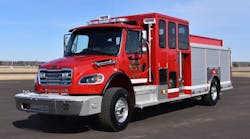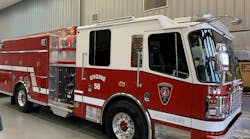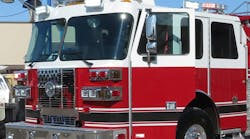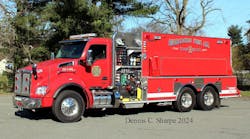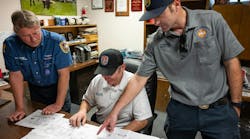The previous installment of The Apparatus Architect series highlighted two well-designed new units, one an engine from the Mount Joy Fire Department and a tractor-drawn aerial ladder from the Eden Fire Company, both in Lancaster County, PA (January 2007). Both of these departments did their homework to develop specifications that would result in a new apparatus which would meet the needs of the department and their first-due areas. In this article, we will review several other departments' efforts to detail the design criteria for their new rigs.
The Syracuse Fire Department in upstate New York operates 10 engine companies, six truck companies, a rescue company and several aircraft rescue and firefighting (ARFF) units from 12 stations that are strategically located throughout the city. Beginning in 1972, the fire department underwent a major restructuring of operations with new stations and relocation of companies to deliver services more efficiently.
As part of this transformation, the department's apparatus fleet was completely replaced in a four-year period. Small attack units were termed "mini pumpers" and each carried a 250-gpm PTO-driven pump, 200-gallon water tank, two crosslay lines and a bed of supply line. The term "maxi pumper" was coined to describe the first newly delivered pumpers. At the time, these engines were equipped with 1,500-gpm single-stage pumps, 500-gallon water tanks with Rapid Water, 50-foot TeleSqurt booms, four crosslays and rescue-style body compartments. For its time, when combined with automated pump controls, remote-control hydrant valves and the associated mini pumper, the standard Syracuse engine company was a formidable force on the fireground.
Over the years, certain technology worked well and was adopted on all later apparatus acquisitions throughout the department. The department's current engine fleet is equipped with the 50-foot version of the TeleSqurt, 2,000-gpm pumps, class A and B foam systems, front trash lines and four crosslays that are all piped with 2½-inch full-flow valves and plumbing. Hinged body doors have given way to roll-up shutter doors, the chassis are equipped with automatic onboard lubrication systems and all bodywork is fabricated from stainless steel to combat the harsh upstate winters.
The Syracuse Fire Department is under the command of Chief John T. Cowin and protects a city of approximately 150,000 residents in a 25-square-mile area. The fire department Apparatus Advisory Committee is headed by District Chief David Reeves. Reeves and representatives from the maintenance division, training, officers and company members provide the necessary input to allow the department to fully develop its specifications for all new apparatus. Over the years, as each batch of pumpers was delivered and placed into service, one could notice subtle changes and improvements that reflected feedback from the companies as well as from the maintenance shops, which developed a history of each rig and its performance with respect to down time and any other problems.
The most recent deliveries were American LaFrance units placed into service at Engine Company 3 and Engine Company 6. These units were built on the ALF Eagle 134 cab with a 200-inch wheelbase. With an overall length of 31 feet, seven inches, these units are very maneuverable in the inner city and are designed to be compatible with other units in the fleet. In particular, the pump panel and operating controls are laid out in a logical fashion for the driver and all controls are color coded to match the crosslay lines. Cab interiors are outfitted with EMS cabinets with a roll-up door and side-facing scene lights improve lighting around the perimeter of the apparatus.
Each of the engines is also equipped with a portable Task Force Tips Blitzfire monitor that can be supplied by 200 feet of lightweight attack line. Together with the four crosslays and the TeleSqurt boom, a Syracuse engine company can easily develop over 2,000 gpm at working fires. Each engine is equipped with split beds of 700 feet of four-inch hose and with a very strong, largely gravity-fed water supply, the fire department has the ability to develop both handline and large-caliber streams at any incident.
If your department is contemplating the purchase of a new pumper or an apparatus with an elevated water tower, a visit to the Syracuse Fire Department may provide your committee with valuable information regarding operations and apparatus. Over the years, the fire department has placed more than 30 maxi pumpers in service from various manufacturers and has a great deal of experience in this area.
Although replacing the whole fleet in a four-year period has worked well in Syracuse and many other larger cities, with fleets that are equipped with 10 apparatus or less, it should be avoided as it may cause a financial hardship on the jurisdiction that now has to come up with funding to once again replace the whole fleet at once 10 or 15 years down the road. With fire apparatus representing the second-largest capital expenditure, other than a new fire station, that a fire department will undertake, it makes financial sense to spread these large capital expenditures out over time to lessen the tax burden on the local community. Moreover, in the volunteer sector, an apparatus purchase represents a morale boost and it does little good to replace multiple apparatus at one time and then go a long period before another apparatus is purchased.
The Waldorf Fire Department in Charles County, MD, operates five engines, one tanker, one heavy rescue and a tractor-drawn ladder truck from two stations. Operating as Station 3 and Station 12, the company responds to over 3,100 calls annually with its volunteer force. Its first-due area is comprised of a large commercial area with numerous strip stores as well as townhouses, schools and single-family homes. The area serves as a bedroom community for the greater Washington, DC, area and includes the heavily traveled Route 5/Route 301 corridors. Under the command of Chief Dan Stevens, the department responds to calls throughout Charles County and neighboring Prince George's County on a first-alarm basis.
Where a number of fire departments have chosen to "supersize" their apparatus, the Waldorf Fire Department has always taken a more conservative and practical approach. American LaFrance built its newest engine with an ALF Eagle 134 cab on a 166-inch wheelbase. Engine 31 has an overall length of just 29 feet, three inches and yet carries all of the required engine company equipment, together with a 500-gallon water tank, 10-kilowatt hydraulic generator, light tower and hydraulic rescue tool.
The body and compartment doors on Engine 31 were fabricated of stainless steel and the unit is equipped with a front trash line, two crosslays and three additional attack lines in the rear hosebed. By carefully designing the enclosed compartment space, the department met all of its requirements while keeping the apparatus to a reasonable size.
It is always possible to make a rig just a little bit bigger than the one it may be replacing under the adage that "you never know what you might need." Unfortunately, as apparatus get larger and heavier, many other dynamics come into play and what you may have designed on paper may not operate well once you get the new rig out into the community. Often, a smaller, more maneuverable rig will be the one that will best meet the operational and tactical needs of the department. As we go around the country evaluating apparatus fleets, rarely do we find that all the apparatus will be within legal axle weights limits or their gross vehicle weight rating (GVWR).
Previous articles in this series have spoken about determining the mission of the vehicle and making sure that an apparatus design will meet the needs of the department. While not completely a lost art, the ability to package five pounds of equipment in a three-pound container is often the solution, rather than simply making the apparatus as large as your station can accommodate.
The next installment of The Apparatus Architect will discuss some of the issues faced when rebuilding apparatus to extend its life cycle.
TOM SHAND, a Firehouse contributing editor, is a 33-year veteran of the fire service and works with Michael Wilbur at Emergency Vehicle Response, consulting on a variety of fire apparatus and fire department master-planning issues. He is employed by American LaFrance and is assigned to the Hamburg, NY, facility. MICHAEL WILBUR, a Firehouse contributing editor, is a lieutenant in the New York City Fire Department, assigned to Ladder Company 27 in the Bronx, and has served on the FDNY Apparatus Purchasing Committee. He consults on a variety of apparatus-related issues around the country. For further information, access his website at www.emergencyvehicleresponse.com.

